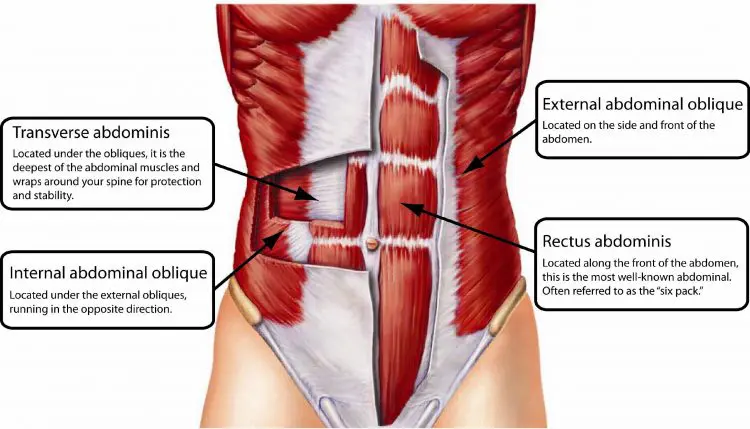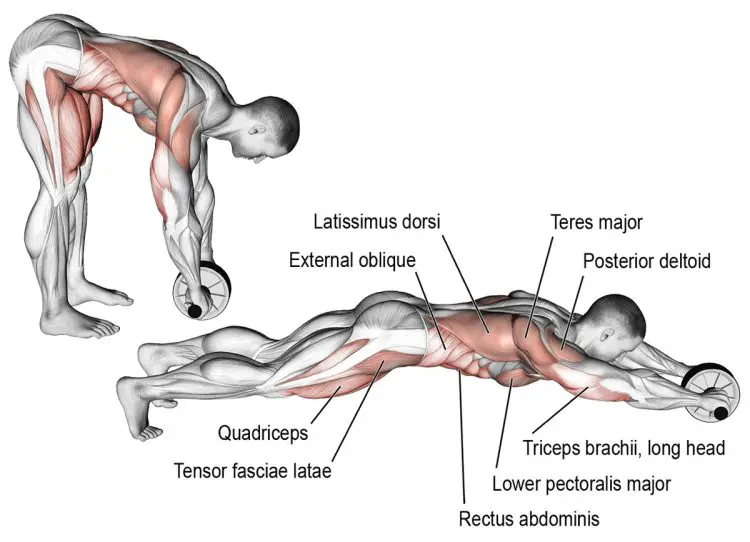When it comes to abs and core training, a lot of people automatically gravitate toward bodyweight exercises. While moves like crunches, planks, and sit-ups can be useful, for a lot of exercisers, they’re just too easy. As a result, they end up doing sets of 30, 50, or even 100 reps to achieve any kind of overload effect. What a waste of time!
Also, such high-rep training might be great for developing muscular endurance but is nowhere near as useful for increasing strength or muscle size. After all, how big or strong do you think you’d get doing sets of 100 squats or curls?
When it comes to strength and size, lower reps, and more weight are usually best.
The good news is that there are plenty of effective abs and core exercises that are intense enough that even the most advanced lifter will find them challenging, and the rollout is one of the best.
Rollouts: Muscles Worked and Benefits
You don’t need to be an expert in anatomy and physiology to enjoy the benefits of the exercises in your workout. However, it can be useful to know what muscles you are using when you perform your chosen movement. Knowing some basic muscle names and functions can help you chose the right exercise for your goals and ensure you aren’t doing too much for one area of your body.

Rollouts involve the following main muscles:
Level Up Your Fitness: Join our 💪 strong community in Fitness Volt Newsletter. Get daily inspiration, expert-backed workouts, nutrition tips, the latest in strength sports, and the support you need to reach your goals. Subscribe for free!
Rectus abdominis – this is the muscle on the front of your abdomen, which is responsible for spinal flexion. When well-developed, and providing you are lean enough, this is the muscle that forms your six-pack.
Obliques – basically your waist muscles, during rollouts, the obliques work isometrically or statically to stop your hips from twisting.
Transverse abdominis – this muscle is part of your inner abdominal unit, a group of muscles responsible for creating intra-abdominal pressure, or IAP for short. IAP helps stabilize your spine from within. Transverse abdominis works like a corset or weightlifting belt and, when it contracts, squeezes inward to compress your abdominal contents.
Pelvic floor – the muscle at the bottom of your inner unit. The pelvic floor helps support your pelvic organs and maintain intra-abdominal pressure.
Diaphragm – your main breathing muscle, the diaphragm contracts and flattens to seal the top of your inner unit.
Iliopsoas – also known as your hip flexors, this muscle is made up of two individual parts; the iliacus and psoas major. However, because they always work together, they’re almost always referred to as the singular iliopsoas. This is one of the muscles used during the couch stretch.
Latissimus dorsi – while rollouts are mainly an abdominal and core exercise, the lats are also strongly involved. The arm action in rollouts is a lot like doing dumbbell or barbell pullovers.
There are several reasons you should include rollouts in your abs and core workout. The main ones are:
- Challenging – if you’ve never done rollouts before, you may be surprised at how hard they are. Remember, when it comes to getting stronger or building muscle, harder is good!
- Functional – rollouts are a full-body compound exercise. They involve your legs, arms, and core, all of which have to work together as a single, synergistic unit. This is how your body usually works in nature.
- Progressive – there are several ways to regress and progress rollouts. This means that, instead of just doing fewer or more reps, you can make this exercise easier or harder by changing how it is performed. For example, you can go from kneeling to standing or from a short range of motion to a longer one.
- Variety – you can do rollouts using an ab wheel or a barbell, and there is a variation that uses nothing more than a towel. It is also possible to simulate rollouts using a suspension trainer.
- Time-efficient – rollouts are so demanding that you probably won’t need to do any additional exercises for your abs and core. This makes it a very time-efficient exercise. Three sets of 10-15 reps of the version that best matches your current level of strength should be all you need.
- Full-body tension – you’ll probably feel rollouts in your abs, but to do them properly, you need to generate full-body tension. You’ll notice that this exercise feels easier when you learn to use your whole body to do it, rather than relying on just your abs. This is a useful skill that should positively affect your performance of lots of different exercises, including squats, deadlifts, pull-ups, power cleans, and kettlebell swings.
How to Perform Rollouts
To get the most from this or any other exercise, you must do it correctly. This will ensure you maximize the effectiveness of your chosen exercise while minimizing any risk of injury.
Follow these instructions and, if you are still in any doubt, ask a personal trainer for additional instructions.
- Hold the handles of your ab wheel firmly with an overhand grip. Kneel down on an exercise mat. Fold your mat in half if you need more padding under your knees.
- Place the roller on the floor just in front of your knees. Brace your abs and straighten your arms. Pull your shoulders down and back for stability. This is your starting position.
- Maintaining core tension, roll your wheel along the floor and away from you. Extend your arms as far as you can without hyperextending your lumbar spine. Try to lower your chest and abdomen down to within a couple of inches of the floor. Your body should be straight, or very close to it, at the midpoint of your rep.
- Using your abs, lats, and hip flexors, pull the wheel back in toward your legs, lifting your body back up as you do so.
- Take a breath, reset your core, and repeat.
Variations and Alternatives
While rollouts are a challenging and effective exercise, they are not always practical or even possible. Beginners may find them very hard to do correctly, and more advanced exercisers could eventually find them too easy. You may not have access to an ab wheel either. Here are TEN variations and alternatives so you can always enjoy the benefits of rollouts, even if you can’t do the version described above.
1. Rollouts Against a Wall
Doing your first rollout can be hard. It can be tricky to control the wheel and stop it rolling too far away from you. And, the further away you move the wheel, the harder this exercise becomes.
Fix all these problems by doing your rollouts against a wall. The wall will stop the wheel from rolling too far too soon, and you can use the wall to precisely control your range of motion. As you get stronger, move further from the wall so you can lower yourself closer to the floor.
2. Uphill Rollouts
If regular rollouts are too demanding for you right now, try doing them uphill. This makes them considerably easier. Move to less steep slopes and then the flat floor as you get stronger.
Incline sit-up boards are a good option for this exercise. You can also do downhill rollouts to make this exercise harder.
3. Standing Rollouts
Standing rollouts are a big step up from the kneeling version, so make sure you are comfortable and confident on your knees before you try it. If you can’t do ten perfect reps on your knees, you aren’t ready to do it standing.
Control your range of motion by doing standing rollouts near a wall. This will stop your ab wheel rolling away from you.
Level Up Your Fitness: Join our 💪 strong community in Fitness Volt Newsletter. Get daily inspiration, expert-backed workouts, nutrition tips, the latest in strength sports, and the support you need to reach your goals. Subscribe for free!
4. Suspension Trainer Rollouts
You don’t need an ab wheel to do rollouts. You can use a suspension trainer, like a TRX, instead. This exercise can be done kneeling or standing, and you can adjust the length of the straps to make the exercise easier or harder too.
Shorter straps make rollouts easier as your body is more upright. With longer straps, your body will be closer to parallel, which will make the movement more challenging.
5. Barbell Rollouts
With this variation, you can make your workout more demanding by increasing the weight, which is something you can’t do with an ab wheel. Just load a barbell or EZ bar with a couple of circular (not hexagonal) weight plates and get to work!
This is also a good option if your gym doesn’t have an ab wheel. You can do barbell rollouts kneeling or standing.
6. Slider Rollouts
You can do rollouts even if you don’t have an ab roller, barbell, or suspension trainer. In fact, all you really need is some smooth floor and a towel. Kneeling or standing, put your hands flat on a towel and then slide it away from you.
As an extra advantage, pulling the towel back toward you is much harder than rolling an ab wheel, so this is a good option for more advanced exercisers.
7. Inchworms
If you are in a prison cell or stranded on a desert island, you can still do an exercise similar to rollouts – inchworms. With this exercise, instead of rolling a wheel away from you, you just walk your hands forward and backward.
This walking action also introduces a small element of lateral instability to your workout, which increases oblique and core activation.
8. Rollout with Bands
If you have completely mastered kneeling rollouts but aren’t quite ready or just don’t want to try standing rollouts, this is the exercise for you. Using light bands will make this exercise just a little harder, while stronger bands will really challenge your abs.
Best of all, you can change the strength of your bands to make this exercise progressive. Make sure the band is secured to a strong anchor because, if it slips, it could hit you in the face.
9. Assisted Rollouts with Bands
In the last exercise, we used bands to make rollouts harder. However, you can also use those same bands to make this exercise easier. Attach your band to an anchor behind you and then around your waist.
Doing kneeing or standing rollouts, the band will support some of your body weight, taking stress off your abs. This is a lot like doing band-assisted pull-ups and chin-ups.
10. Wheelbarrows Walks
This is a great exercise if you work out with a training partner. It works the same muscles as rollouts or inchworms but is just a little more difficult because your partner is holding your feet up, which puts more weight on your arms. There is also some extra lateral movement to increase oblique activation.
Take it easy with this exercise as raising your feet could also put more pressure on your lower back. Do not allow your hips to drop out of alignment, and make sure your partner understands that they MUST put your feet down when you ask them to.
Important Rollout Tips
Get even more from rollouts and the ten variations and alternatives outlined above with these handy tips!
Take care of your lower back – while rollouts are an abs and core exercise, they can be hard on your lower back. If your abs start to fatigue, there is a real risk that you will hyperextend your lumbar spine. This could cause SERIOUS injury. If you can feel any of these exercises in your lower back, you should stop immediately and use an easier variation.
Don’t hold your breath – while holding your breath is an effective way to increase intra-abdominal pressure, it can also cause a large increase in your blood pressure. Avoid this problem by inhaling as you roll your ab wheel away and exhaling as you pull it back toward you.
Use but don’t abuse this exercise – one of the reasons we like rollouts is that they are significantly more challenging than many other abs exercises. However, this means they also take more out of your body, and you may need longer between workouts to recover. Don’t do rollouts too often. Instead, do them no more than 2-3 times a week on non-consecutive days. If you do them more often than that, you risk overtraining and injury.
Remember, rollouts are also a lat exercise – if you care about your performance, don’t do rollouts before lat pulldowns, pull-ups, pulldowns, rows, or deadlifts. Rollouts are a lot like pullovers, and doing them before any lat exercises could mean you are tired before you even start.
Low reps work best – get the most from rollouts by doing low to moderate-rep sets. If you can do more than 10-15 reps, you should upgrade to a more demanding version. Doing fewer reps means you can focus 100% on keeping your spine neutral, bracing your core as hard as you can, and generating full-body tension. Focus more on quality than quantity with this exercise.
Wrapping Up
If you want to take your abs and core training to a new, higher level, rollouts could be the exercise you have been looking for. Plus, with ten variations and alternatives to choose from, you’ve got all the options you need to continue making progress with this exercise for years to come.
Rollouts, even the kneeling version, are not easy to master. Even if you’ve got reasonably well-conditioned abs, you should expect some DOMS (delayed onset muscle soreness) after doing this exercise for the first time. But that’s what makes this such a good exercise – it’s harder than those all-too-common crunches and sit-ups.
Build your strongest abs and core ever with rollouts!
Interested in measuring your progress? Check out our strength standards for Dumbbell Pullover, Sit Ups, Pull Ups, and more.










